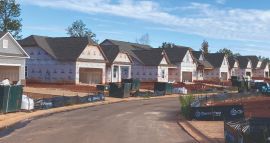Builders can’t construct fast enough to solve acute housing shortage
Contributing Writer //August 4, 2023//


Builders can’t construct fast enough to solve acute housing shortage
Contributing Writer //August 4, 2023//
After a promising start early in the year, existing home sales have fallen steadily in recent months to the lowest level in years. On the surface it appears that the housing sector is experiencing serious difficulty. While higher mortgage rates have taken a toll, the bigger problem is a serious shortage of available housing.
 There is a near-record low level of homes available for realtors to sell. As a result, home prices are once again climbing and home buyers are looking at new homes which are in more abundant supply. The heightened demand for new homes has boosted builder confidence and they are trying to rapidly boost the pace of construction but are running into difficulties of their own.
There is a near-record low level of homes available for realtors to sell. As a result, home prices are once again climbing and home buyers are looking at new homes which are in more abundant supply. The heightened demand for new homes has boosted builder confidence and they are trying to rapidly boost the pace of construction but are running into difficulties of their own.
In addition to the shortage of single-family homes and condos for sale, there is also a shortage of properties for rent. The bottom line is that we need more housing and builders are unable to keep pace with the demand. That implies higher home prices, higher rent and higher inflation. The Fed’s path to a 2.0% inflation rate is littered with potholes.
Existing home sales fell 3.3% in June to 4,160,000 which is roughly the same as the low points reached during both the 2020 recession and the so-called “Great Recession” of 2008-2009. On the surface one might reasonably conclude that the demand for housing has plummeted. But be careful, that might not be the right conclusion.
While existing home sales have plunged during the past year, the primary reason is a shortage of homes available for sale. In fact, there are currently 1,080,000 homes available for sale. That is a near-record low level. The reason for the shortage is that current owners are unwilling to sell. They likely have a 3.0-3.5% mortgage rate and would have to trade that for a near-7.0% mortgage rate on their next property. Not an enticing situation.
To put this same inventory situation in slightly different terms, there is currently a 3.1-month supply of homes available to sell. Compare today’s situation to the 2008-2009 period when there was a 10-12 month supply of available homes. Everybody was anxious to sell and the abundant supply caused home prices to plunge 15-20%. That is not the situation today.
Home sales peaked a year ago at $413,800. As the Fed steadily pushed interest rates higher the housing market softened and prices began to fall. After falling for seven straight months, prices have now risen for five consecutive months and at $410,200 are within an eyelash of last year’s record high level. One-third of the homes sold in June were at prices above asking. Bidding wars have once again become common.
The average home sold in June was on the market for just 18 days. In fact, 76% of the homes sold in June were on the market for less than a month. Compare that to the 3-4 month period that was required to sell a home a decade or so ago. It would be a serious mistake to view the current housing market as weak.
That does not mean that the market has not softened. Housing affordability has dropped sharply from a few years ago. Clearly, it has become more difficult for many buyers — particularly first time purchasers — to afford a house today than it was a few years ago. But still, the figures cited above indicate clearly that even with reduced affordability the demand for housing remains solid.
As the population grows and people graduate from school and start jobs, they need a place to live. For those interested in purchasing a home, there are few existing homes available that might suit their needs. For this reason, many are now looking for an affordable new home. With a 6.7 month supply, those potential purchasers are having more success.
As the demand for new homes increases builders are becoming increasingly more optimistic. Homebuilder confidence has risen for seven straight months but builders are grappling with a shortage of workers, supply-side challenges like an ongoing scarcity of electrical transformer equipment, and increasing difficulty in finding available lots on which to build. As a result, builders are having difficulty stepping up the pace of construction quickly enough to satisfy demand.
Other people seeking a place to live might look for a place to rent but they, too, are facing challenges. At 6.4% the vacancy rate for rental properties is the lowest it has been since the early 1980’s. Against this background rents have risen almost 9% in the past year – the fastest on record for a series that stretches back to 2002. This matters because rents represent one-third of the entire CPI index.
The bottom line is that whether you desire to purchase a home or rent, housing is in short supply. Builders seem unable to keep pace given the constraints on their ability to hire workers and lingering supply-side shortages. That seems to suggest a situation where both home prices and rents will continue to climb. If builders cannot quickly boost production, then the Fed will have to reduce demand via rate hikes which may well exceed the additional 0.5% that the market expects at the moment.
From 1980 until 2003, when he retired, Stephen Slifer served as chief U.S. economist for Lehman Brothers in New York City, directing the firm’s U.S. economics group along with being responsible for forecasts and analysis of the U.S. economy. He has written two books on using economic indicators to forecast financial moves and previously served as a senior economist at the Board of Governors of the Federal Reserve in Washington, D.C. Slifer can be reached at www.numbernomics.com.
g
















